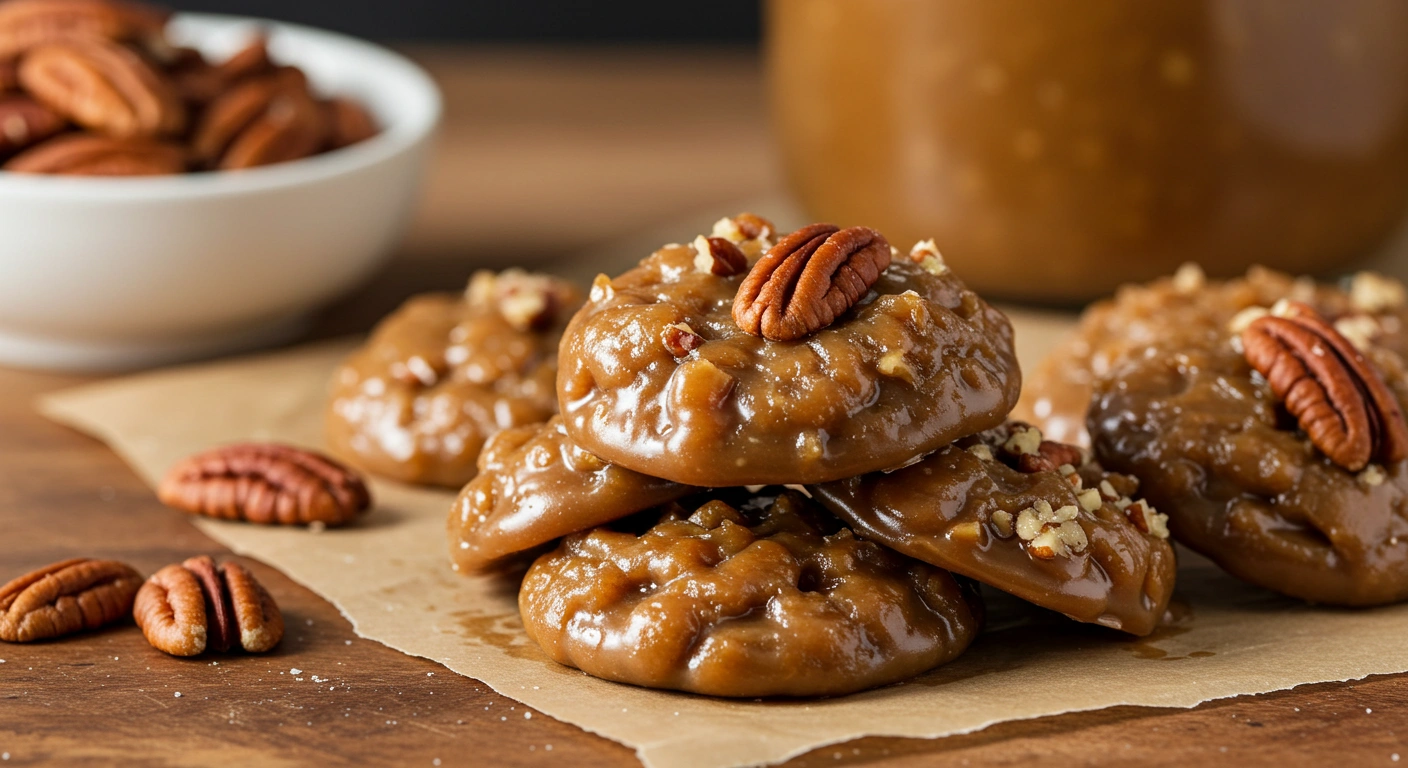Classic Louisiana Pralines – A Southern Delight
Introduction to Louisiana Pralines
Pralines are one of the South’s most beloved confections, especially in Louisiana, where they have become a staple treat. These delicious, creamy, pecan-laden sweets have roots dating back centuries and hold a special place in Southern culinary tradition.
Originally brought to Louisiana by French settlers, pralines were adapted to include pecans, which were abundant in the region. Over time, the recipe evolved into the classic Louisiana praline—a melt-in-your-mouth candy with a delicate balance of caramelized sugar and nutty goodness.
Whether you’re visiting the lively streets of New Orleans or trying your hand at making them at home, pralines are a must-try dessert that embodies the heart and soul of Louisiana cooking.
Ingredients for Classic Louisiana Pralines
The key to making perfect Louisiana pralines is using the right ingredients. Here’s what you’ll need:
Essential Ingredients:
- Granulated sugar – Provides the primary sweetness and texture.
- Brown sugar – Adds a rich, caramel-like depth of flavor.
- Heavy cream or evaporated milk – Gives pralines their signature creamy texture.
- Unsalted butter – Enhances richness and smoothness.
- Pecans – The star ingredient, offering a crunchy contrast to the creamy base.
- Vanilla extract – Adds warmth and enhances the overall flavor.
- A pinch of salt – Balances sweetness and brings out the flavors.
Ingredient Variations:
- Some recipes use half-and-half instead of heavy cream for a lighter texture.
- Maple syrup or bourbon can be added for a unique twist.
- A touch of cinnamon or nutmeg can enhance the praline’s warmth.
Step-by-Step Guide to Making Louisiana Pralines
Preparing the Ingredients
Before you start cooking, make sure all ingredients are measured and ready to go. Praline-making requires precise timing, so having everything within reach will make the process smoother. Also, line a baking sheet with parchment paper or a silicone mat for easy cleanup.
Cooking the Sugar Mixture
In a heavy-bottomed saucepan over medium heat, combine the granulated sugar, brown sugar, heavy cream (or evaporated milk), and butter. Stir constantly to prevent scorching. Once the mixture reaches a smooth consistency, insert a candy thermometer and continue stirring until the temperature reaches 235–240°F (soft ball stage).
Adding Pecans and Flavoring
Once the mixture reaches the correct temperature, remove it from heat and stir in the pecans, vanilla extract, and a pinch of salt. Continue stirring for a minute or two until the mixture thickens slightly. This step is crucial to achieving the right consistency.
Cooling and Shaping the Pralines
Using a spoon, quickly drop dollops of the mixture onto the prepared baking sheet. Let them cool at room temperature until they harden. The pralines should be firm yet slightly creamy when bitten into.
Tips for Perfect Pralines Every Time
Making pralines can be tricky, especially for first-timers. However, with a few expert tips, you can achieve the perfect texture and flavor every time.
Achieving the Right Texture
- Use a candy thermometer: Ensuring the sugar mixture reaches the correct temperature (235–240°F) is crucial. Too low, and the pralines won’t set properly; too high, and they’ll become too hard.
- Stir constantly but carefully: While stirring is essential to prevent burning, over-stirring can cause the sugar to crystallize, leading to a grainy texture.
- Let the mixture thicken slightly before scooping: If the mixture is too runny when dropped onto the baking sheet, it may spread too thin. Allow it to cool for a minute or two to achieve the right consistency.
Avoiding Common Mistakes
- Don’t cook on high heat: Cooking the sugar mixture too fast can lead to burnt pralines or an uneven texture. A slow and steady medium heat works best.
- Avoid making pralines on humid days: Humidity can affect the way the sugar sets, making the pralines sticky instead of firm.
- Measure ingredients precisely: Praline-making is a delicate process, and slight deviations can impact the final result.
Storage and Shelf Life
- Store in an airtight container: Pralines can absorb moisture from the air, causing them to lose their crisp texture.
- Keep them at room temperature: While refrigeration is not necessary, it can help extend their shelf life if your environment is particularly humid.
- Freeze for long-term storage: If you need to store pralines for an extended period, freeze them in a sealed container with parchment paper between layers.
Variations of Classic Louisiana Pralines
While the traditional praline is already delicious, there are several variations to try for a new twist on this classic treat.
Chocolate Pralines
For chocolate lovers, adding cocoa powder or melted chocolate to the mixture can create a rich, fudgy version of pralines. Dark chocolate works best, as it balances the sweetness of the candy.
Maple Pralines
Substituting maple syrup for some of the sugar gives pralines a deep, caramel-like flavor with a hint of smokiness. This version pairs well with walnuts instead of pecans.
Coconut Pralines
Adding shredded coconut to the mixture gives pralines a chewy texture and a tropical flavor. Coconut pralines are especially popular in Caribbean-influenced regions of Louisiana.
Pairing Louisiana Pralines with Other Southern Treats
Pralines are delightful on their own, but they also pair well with other Southern desserts and drinks.
Best Drinks to Enjoy with Pralines
- Coffee: The bitterness of black coffee balances the sweetness of pralines beautifully.
- Sweet Tea: A classic Southern drink that complements pralines without overpowering them.
- Bourbon: The caramel and vanilla notes in bourbon enhance the flavors of pralines.
How Pralines Complement Other Desserts
- Pecan Pie: Serving pralines alongside pecan pie creates a double dose of nutty sweetness.
- Vanilla Ice Cream: Crumbling pralines over ice cream adds a crunchy, caramelized topping.
- Beignets: Enjoying pralines with New Orleans’ famous beignets is a perfect way to indulge in Louisiana’s best sweets.
The Cultural Significance of Pralines in Louisiana
Pralines are more than just a sweet treat; they are an essential part of Louisiana’s culinary and cultural heritage.
Pralines in New Orleans Cuisine
New Orleans, the heart of Creole and Cajun cuisine, is famous for its pralines. They are sold in nearly every corner shop, candy store, and market throughout the city.
Role in Festivals and Celebrations
Pralines are a common sight at Louisiana festivals, such as Mardi Gras and the New Orleans Jazz & Heritage Festival. They are often given as gifts, enjoyed during holidays, and even used as wedding favors.
Homemade vs. Store-Bought Pralines
Should you make pralines at home or buy them from a local shop? Both options have their benefits.
Pros and Cons of Homemade Pralines
Pros:
- Control over ingredients and flavors
- Freshly made, ensuring the best texture
- Customizable with personal twists
Cons:
- Requires precision and technique
- Can be tricky for beginners
- Takes time to perfect
Best Places to Buy Pralines in Louisiana
If you prefer to buy pralines, some of the best places to find authentic ones include:
- Aunt Sally’s Pralines (New Orleans) – One of the most famous praline shops in the city.
- Southern Candymakers (New Orleans) – Known for their traditional and chocolate pralines.
- Leah’s Pralines (New Orleans) – A family-owned shop with a rich history.
Frequently Asked Questions About Louisiana Pralines
1. Why do my pralines turn out grainy?
Grainy pralines usually result from over-stirring or the sugar crystallizing too early. Make sure to stir gently and consistently, and avoid making them on humid days.
2. Can I use different types of nuts?
Yes! While pecans are traditional, you can use walnuts, almonds, or even macadamia nuts for a unique twist.
3. How long do pralines last?
Pralines can last up to two weeks at room temperature in an airtight container. If stored properly in the freezer, they can last for several months.
4. Can I make pralines without dairy?
Yes, you can substitute heavy cream with coconut milk or almond milk, and use dairy-free butter for a vegan-friendly version.
5. Are pralines similar to caramel?
While pralines and caramel share similar ingredients, pralines have a grainier, fudgier texture due to the crystallization of the sugar, whereas caramel remains smooth and chewy.
Pralines are a timeless Louisiana tradition, combining the richness of caramelized sugar with the nutty crunch of pecans. Whether you make them at home or buy them from a classic New Orleans shop, these sweet treats capture the essence of Southern hospitality. Try making your own batch today and experience the magic of Louisiana pralines!

